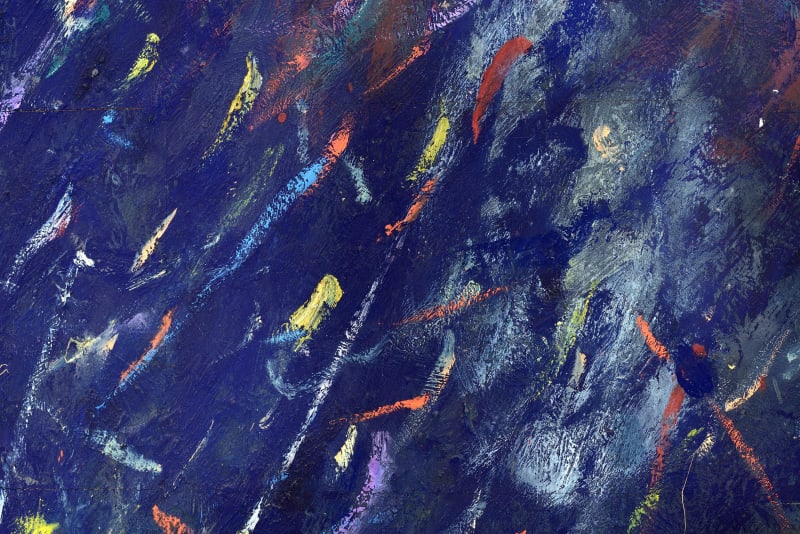BY ATTICUS BERGMAN
Pier Paolo Calzolari was born in 1943 and emerged in the 1960s as a seminal figure of the Arte Povera movement, before eventually distancing himself from its foundational ethos and creative philosophy. His new show at Marianne Boesky, “Painting as a Butterfly,” is his first in New York since 2017.
When I visited the show, which opens March 18 at both of Marianne Boesky’s adjoining galleries, there were several paintings that reminded me of ceiling tiles. This is because of their idiosyncratic texture, which Calzolari engineers by gluing vast quantities of salt to flannel surfaces so that, each time he applies pigment, the color is absorbed into a firm layer of crust whose granularity thenceforth exudes a coy tactility, both yielding and severe.
As I moved through the exhibition, I found myself thinking about ceilings again when I was confronted with Monocromo blu (1979), a 35-foot-long painting that the artist made while remembering the experience of gazing up at the sky from the back of a donkey cart. From this description, one would expect the painting to reflect the majesty and refulgence of the heavens. Instead, the paint has a dull, congealed quality that feels defiantly inorganic—an effect which is amplified by the rectilinear matrix of yellow adhesive seams that, quite literally, hold the painting together. If there is any majesty to this painting’s interpretation of the sky, it lies on the other side of a ceiling—a ceiling that, in this case, is marked by the opaque barrier of the painting’s artificial appearance, which studiously deflects any feelings of awe that one might otherwise be tempted to feel.
In Rideau V (1984), a more porous barrier presents itself: the sky viewed through curtains. Or, in other words: a window. Curtains have historically been a recurring theme in Calozari’s work, simultaneously announcing and obscuring a threshold that conceals as much as it divulges.
When I inquired about the processes of erasure and negation that inform the pathos of his work, Calzolari once again revealed his interest in the firmament, referencing the existential anxiety of imagining himself “lost in the night sky.” It’s an evocative image whose melancholic overtones are consistent with the last five decades of his exhibitions. These have tended to include a rotating cast of inscrutable objects that, in retrospect, are inflected by a register of emotions not always evident when viewed in isolation.
In “Painting as a Butterfly,” there are clam shells attached to multiple paintings. Elsewhere one can spot an egg, a walnut, a feather, an unusually long dress, a collection of flower petals and, perhaps most importantly, an illuminated candle. When I took advantage of this candle to ask Calzolari about his relationship to light, he responded by emphasizing that, for him, “light is always matter,” implying that, in his mind, there is a physicality inherent to the phenomenon of illumination itself—a perspective which no doubt does much to explain the husky materiality that both curdles and abuses his renditions of the sky.
Calzolari’s long-standing fascination with the mystery of transformation is profoundly entwined with his understanding of light—or, more specifically, by the ambiguity of its flickering and, ultimately, the possibility of its extinguishment. “Let there be light,” said God in the book of Genesis. Or, as Calzolari puts it: “Without light, you are nothing. With that flame, you are flesh.”


